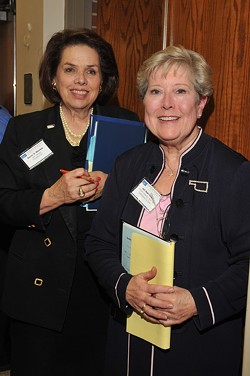
Oklahoma County Commissioner Willa Johnson has seen her fair share of studies on northeast Oklahoma City during her two decades in public service.
Like most, she didn’t need data or statistics to tell her the community was suffering. It was the area’s decline in economic conditions and quality of life that catapulted Johnson into public office on the Oklahoma City Council in the mid-1990s.
“I’ve watched that area literally go down to absolutely nothing,” Johnson told Oklahoma Gazette. “There were times when we had about four grocery stores. We had all kinds of businesses. It just all went away. It became crime-ridden. All of the negative things that could go on in a community started to happen.”
Johnson advocates for a healthier and more vibrant northeast community. Bringing change to the poverty-stricken area was her goal throughout her 14 years representing Ward 7. She was elected commissioner of northeast Oklahoma County — District 1 — in 2010.
Four years ago, Lynn Institute for Healthcare Research Inc., joined the cause after viewing data supporting generations of high-risk health conditions including diabetes, obesity, hypertension and a high infant mortality rate. The nonprofit embarked on a multi-layered initiative to improve the health of residents living in ZIP codes 73105, 73111 and 73117.
“[The Lynn Institute] summary mirrored what I’ve been talking about for years,” Johnson said. “I think when this summary and data gets out, eyes will light up about what we need. I’ve seen a lot of studies in my life. In my opinion, this one is far better than any I’ve seen.”
Lynn’s approach
Known for its basic medical research and sleep studies, OKC-based Lynn Institute took on a new initiative focused on community health research, planning and community engagement in 2012. The organization’s leaders sought to change the health of a community and established an aggressive four-step approach that included a comprehensive assessment of health outcomes followed by a 10-year plan.
Feb. 29, the nonprofit unveiled The Lynn Lifestyle Summary – Northeast Oklahoma City, a nearly 100-page health document that cites hundreds of government and private studies, feedback from focus groups and community leader input.
Karen Vineyard Waddell, president and CEO, said the summary serves as a springboard for establishing a 10-year plan and ultimately building a healthier community.
“We had groups that wanted us to open clinics in northeast Oklahoma City,” Waddell said. “We thought the work was much bigger than that. We thought coming together was necessary.”
Lynn Institute leaders asked 34 individuals representing health care, nonprofits, local business, government, education and the faith community to form the Healthy Community Collaborative – Northeast Oklahoma City. Led by co-chairs Greg Jones, a northeast businessman, and former Lt. Gov. Jari Askins, the collaborative discusses issues and data outlined in the summary. The group will develop a sustainable 10-year plan and set measurable two-year objectives to change health outcomes.
Decades from now, Lynn Institute leaders predict positive shifts in the community’s health statistics and an overall stronger, more vital community.
“We believe this group is what will change northeast Oklahoma City,” Waddell said.
Blight challenges
OKC’s northeast communities are home to the State Capitol, the Oklahoma Health Center complex and the Adventure District, where the city’s zoo and a handful of museums are located. Despite the employment, lifestyle and wellness opportunities of those three adjacent districts, much of the northeast area is blighted, dominated by homes built before 1959 and abandoned buildings.
Blight does more than negatively impact surrounding property values and economic opportunities; it takes a toll on residents’ overall well-being.
Michael Owens, a Lynn Institute board member, spent eight years working on the northeast side. During that time, he noticed it was difficult to find fresh fruits and vegetables and there were few primary care physicians and fewer walking and bike trails compared to other parts of OKC. Originally from Wisconsin, he found the city’s northeast neighborhoods representative of African-American and minority communities around the country.
“It is difficult for the community, as it stands now, to change the trends and statistics, such as obesity, diabetes and others that tend to plague the African-American community,” said Owens, who also is a member of the collaborative. “That’s why I think this collaborative is so important. It gives leaders, not just in that community but the broader Oklahoma City area, a chance to focus on these specific challenges and collaborate in a way that can solve them.”
Owens said efforts are underway to help the northeast community, like the city’s urban renewal plan, known as Northeast Renaissance Oklahoma City Tax Increment Finance District.
As addressed in the summary, there are 61 nonprofit organizations serving the three ZIP codes home to more than 22,000 residents. They formed Sisters in Motion, an organization that encourages people to walk for improving physical activity and healthier lifestyles. In addition to grassroots groups, the Oklahoma City-County Health Department maintains a health clinic and a variety of wellness programs from its location at 2600 NE 63rd St.
At the state level, there is an Office of Minority Health at the Oklahoma State Department of Health. The state agency conducts public health events specifically focused on the health concerns of minority communities.
The collaborative will work to identify successful efforts and examine ways to expand. Additionally, it will review key health areas where action is needed to remove barriers. Discussion could include crime prevention, transportation, education and employment opportunities.
The collaborative meets next month.
“Our goal is to look at all those trends and to see movement in the opposite direction for a healthier community,” Owens said. “In order for that to happen, we need to engage the community to change behaviors but also bring the missing components.”
Print Headline: Vibrant rebirth, Lynn Institute pursues an aggressive plan to build a healthier northeast OKC community.











